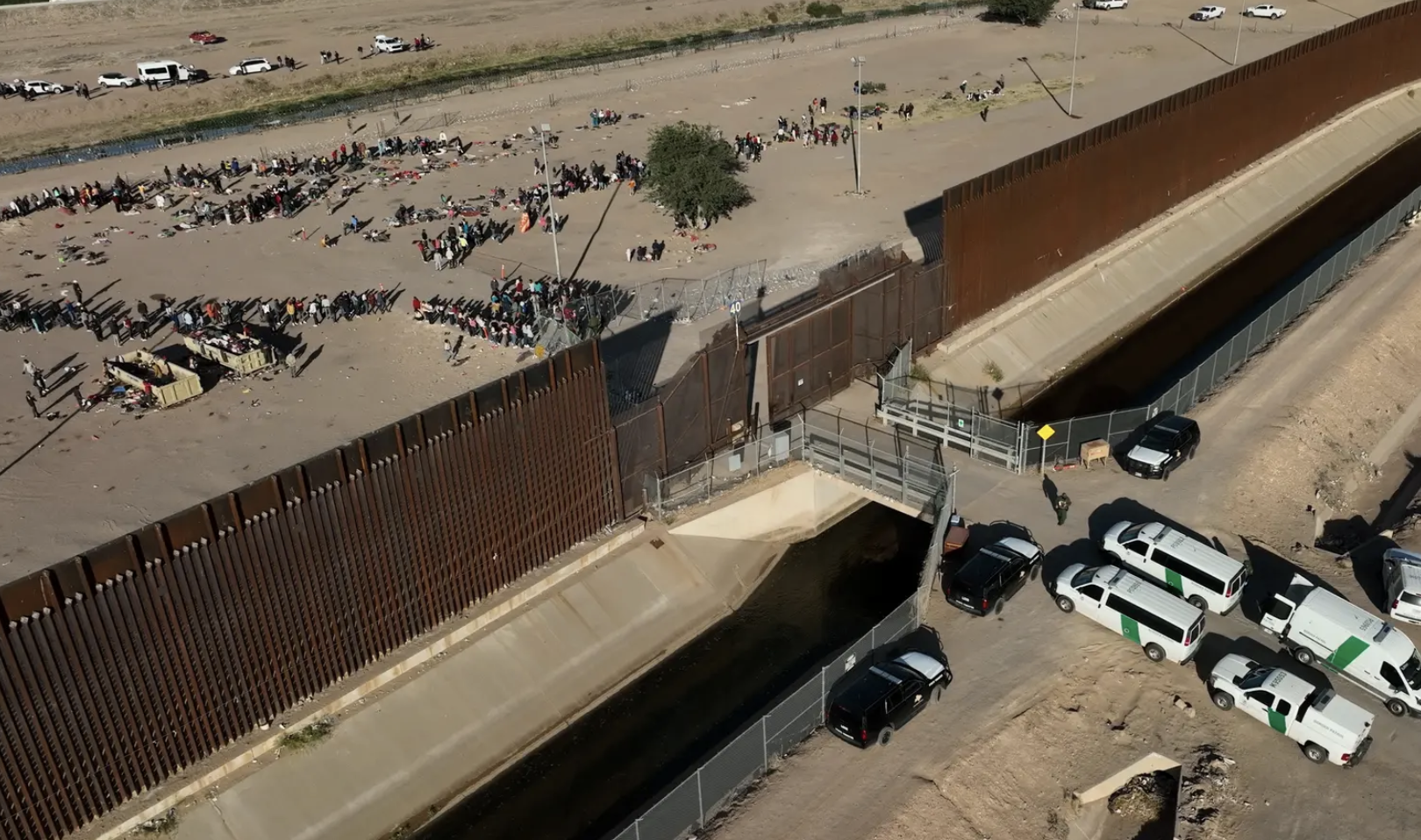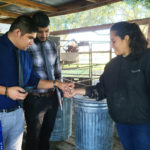In the final hours of Title 42, migrants line up and border cities brace for the unknown

“In the final hours of Title 42, migrants line up and border cities brace for the unknown” was first published by The Texas Tribune, a nonprofit, nonpartisan media organization that informs Texans — and engages with them — about public policy, politics, government and statewide issues.
Sign up for The Brief, The Texas Tribune’s daily newsletter that keeps readers up to speed on the most essential Texas news.
EL PASO — As the clock ticked down to the end of a policy used to expel migrants from the U.S. nearly 3 million times over the past three years, the lines formed again on a patch of American soil between the Rio Grande and the border wall.
Hundreds of migrants — men, women and children — stood in ragged lines, waiting near a gate in the wall for their turn to pass through. They were watched by Border Patrol agents and National Guard members in fatigues. For the moment, no one moved.
A group of four Venezuelan men with a boy and a Colombian couple with their 2-year-old son waded across the shallow river and were turned back by National Guard. The migrants said the soldiers told them the border was closed and they should go to another area 5 miles east where agents may let them pass.
The public health emergency order known as Title 42 — which has been largely used as an immigration enforcement policy to quickly expel migrants, including asylum-seekers, trying to enter the U.S. — ended late Thursday night.
In preparation, federal, state and border officials across the roughly 2,000-mile U.S.-Mexico border have implemented a series of policies to prepare for what they fear will be a chaotic crisis as thousands of migrants who have been forced to wait in Mexican border cities make a crucial decision: Follow the Biden administration’s new rules and make an appointment to request asylum, or try their luck crossing the border en masse.
/https://static.texastribune.org/media/files/9b0f9e426a5361ea69e48650bf6bf2e9/2023-05-11T233723Z_2093330556_RC2JW0A4K354_RTRMADP_3_USA-IMMIGRATION-MEXICO.JPG)
In South Texas, video footage from journalists on Wednesday showed hundreds of immigrants gathering on the banks of the Rio Grande near Brownsville. In neighboring Hidalgo County, County Judge Richard Cortez issued a seven-day disaster declaration on Thursday.
“I have received credible information from officials with Customs and Border Protection that large groups of migrants are probing our international border in search of crossing points,” he said. “I have decided to declare this emergency as a first step in securing all available state and federal resources to ensure the health and safety of our residents.”
El Paso, Laredo and Brownsville had previously declared states of emergency. On Wednesday, El Paso city officials converted two vacant middle schools into migrant shelters using federal money.
After Thursday, immigration agents will seek to deport migrants who attempt to enter the country without first having set up an appointment to enter the U.S. through a port of entry, using a government cellphone app known as CBP One. Migrants also have the option of applying for asylum at one of the new processing centers in Guatemala or Colombia, which will give successful applicants the option to legally enter Canada, Spain or the U.S.
“Starting tonight, people who arrive at the border without using a lawful pathway will be presumed ineligible for asylum,” Homeland Security Secretary Alejandro Mayorkas said in a statement late Thursday. “The border is not open. People who do not use available lawful pathways to enter the U.S. now face tougher consequences, including a minimum five-year ban on re-entry and potential criminal prosecution.”
A couple of hours before Title 42 was set to end, a federal judge in Florida blocked the Biden administration from carrying out a key part of its plan: “paroling” migrants into the country without a formal notice to appear in court. The temporary restraining order came in response to a lawsuit by Florida’s attorney general. Border officials used parole during the Trump administration and under previous administrations.
When the deadline came at 9:59 p.m. local time in El Paso, hundreds of migrants were still in line at the border wall gate, waiting for Border Patrol agents to apprehend them. Men stood in one line, women and children in another.
Whenever agents took a small group of them through the gate, the migrants applauded and cheered.
Earlier Thursday at a migrant camp in Ciudad Juárez, across the river from El Paso, Venezuelan migrant Richard Arcia, 23, said he’ll continue trying to use the app until he can get an asylum appointment. If he’s successful, he said he plans to go to New Jersey, where he has family.
Arcia said he’s spent the past two months in Juárez after leaving Peru, where he lived for five years after his home country’s economy began to collapse amid political instability. He worked for a brewery, distributing beer to businesses, until criminal organizations in Peru began extorting Venezuelan immigrants.
He would pay $54, or two days’ pay, each time. He said one of his friends was killed after refusing to pay.
“What’s better, to live in Venezuela going hungry, or try to cross to find a better life?” he said. “I don’t need the American government to give me anything. I have a support system [in New Jersey], and I’ll get to work as soon as I can.”
Another Venezuelan migrant, 32-year-old Jhonan Polo, arrived at the camp Wednesday with his brother, two nephews and two cousins. The family hopes to get to Boston, where they have a cousin who has lived there for two years.
The camp, outside of a detention center that caught fire in March, killing 40 migrants, has shrunk from an estimated 100 people on Monday to about 60 Thursday evening. Some at the camp said others have left, hoping to sneak into the U.S. or surrender to Border Patrol before Title 42 ends.
Polo said he’ll look for construction work in Juárez until he can get an appointment through the app.
“We want to do it the legal way, God willing,” he said. “I don’t think it’s a secret why we left, or the conditions of my country: bad economy and bad salaries.
“We’re relieved because we’re one step away from a better life,” he added. “We just want to get to work and provide a life to our family that we couldn’t provide in Venezuela.”
Thousands of migrants have crossed the border into El Paso in the days leading up to the change, many of them immediately surrendering to Border Patrol agents. Some have avoided detection and entered the country illegally, sleeping in the streets of the city’s downtown as they try to find transportation to the nation’s interior.
Earlier this week, immigration agents handed out Spanish-language flyers to migrants asking those without permission to be in the U.S. to turn themselves in. On Tuesday, hundreds of migrants who had been camping outside of El Paso’s Sacred Heart Church did so; agents gave them a notice to appear at a later date at immigration offices across the country.
Since March 2020, when the Trump administration invoked Title 42 for the first time, immigration agents have used it about 2.7 million times at the southern border amid a dramatic increase in migration: In fiscal year 2022, which ended in September, agents apprehended immigrants a record-breaking 2.3 million times at the southern border.
Apprehensions have hit 1.2 million on the southern border during the first six months of the current fiscal year.
On Tuesday, border agents apprehended more than 11,000 people who crossed the border illegally — nearly double the number in a typical day, The New York Times reported. After Title 42 lifts, U.S. officials are expecting up to 13,000 migrants to cross the southern border every day.
Ruben Garcia, director of the network of migrant shelters called Annunciation House based in El Paso, said that as of Thursday afternoon, Border Patrol agents already had released 400 migrants to his organization’s shelters — a number he said is higher than normal but manageable.
But that could change after Title 42 ends, Garcia said.
“Your guess is as good as mine,” he said when asked what tomorrow could look like.
On Wednesday, Border Patrol chief Raul Ortiz told reporters in El Paso that he does not expect an increase in illegal crossings after Thursday night.
“The increases that we’ve seen in the last five to six days, I think were really the surge,” he said, according to news outlets. “I think that what we see now is a continued effort by some to message incorrectly that once Title 42 goes away, it’s going to be a free-for-all along the border.”
Among the latest changes in immigration policy, the Biden administration finalized a rule that went into effect Thursday that will deny asylum to migrants who passed through a third country where they could have sought asylum instead.
U.S. Customs and Border Protection acting Commissioner Troy Miller on Thursday said that Mexico will continue to accept 30,000 migrants monthly from Venezuela, Cuba, Haiti and Nicaragua if they try to enter the U.S. illegally and are deported.
“Migrants who enter the United States unlawfully by crossing the southwest border, and not via a lawful pathway, will be returned to Mexico and may be transported away from Mexico’s northern border to locations in southern Mexico,” Miller said. “As we have said many times, the border is not open to irregular migration.”
Immigrant rights advocates have criticized the Biden administration for the third-country asylum policy, which is similar to what the Trump administration had proposed.
Michele Heisler, the medical director for Physicians for Human Rights and professor of internal medicine and public health at the University of Michigan, said she welcomes the end of Title 42, which she said had no public health benefit, but criticized the Biden administration’s new asylum policy as “cruel.”
“This new rule … is likely to cause significant harm to a population that is already highly vulnerable due to the factors that made them seek protection in the first place, compounded by the conditions faced on their journey to the border, including extortion, kidnapping, rape and other forms of physical and psychological violence,” she said.
Shortly before Title 42 ended Thursday night, a group of about 15 migrants crossed the river seeking to join the line at the border wall, but the National Guard refused to let them past the concertina wire between the river and the wall. They waited for about an hour until they gave up and walked away.
Sindy, 34, a Colombian migrant in the group who declined to give her last name, said she had been waiting all day on the U.S. bank of the river with a group of Venezuelan migrants. They decided to cross the river after spending two months in Juárez unsuccessfully trying to get an appointment through the app, she said.
“All this sacrifice for nothing,” she said.
Sindy said she left her two daughters back in Colombia with her mother and was robbed by criminals during the long journey north. She still hopes to get to Houston where her sister lives.
Rebuffed by the soldiers, she and the rest of her group left looking for a place to sleep for the night. They said they had no money.
Jayme Lozano Carver contributed to this story.
Disclosure: The New York Times has been a financial supporter of The Texas Tribune, a nonprofit, nonpartisan news organization that is funded in part by donations from members, foundations and corporate sponsors. Financial supporters play no role in the Tribune’s journalism. Find a complete list of them here.
Tickets are on sale now for the 2023 Texas Tribune Festival, happening in downtown Austin on Sept. 21-23. Get your TribFest tickets by May 31 and save big!
This article originally appeared in The Texas Tribune at https://www.texastribune.org/2023/05/11/texas-border-migrants-title-42-ends-el-paso/.
The Texas Tribune is a member-supported, nonpartisan newsroom informing and engaging Texans on state politics and policy. Learn more at texastribune.org.








